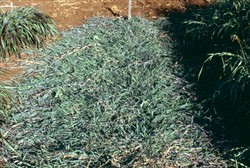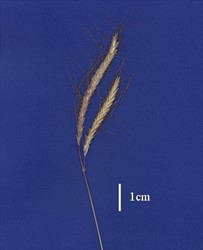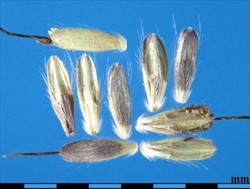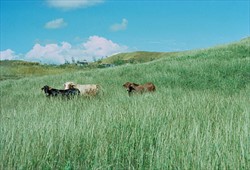Dichanthium caricosum
Tropical Forages
Dichanthium caricosum (L.) A. Camus
Basionym: Andropogon caricosus L.
Family: Poaceae (alt. Gramineae) subfamily: Panicoideae tribe: Andropogoneae subtribe: Anthristiriinae.
Stoloniferous perennial, stolons spreading to 1.5–2 m; tillers erect to 30–80 cm or decumbent, tufted at stolon nodes. Stems often blue-tinged. Leaf blades lanceolate, 4–20 (–30) cm long, 2–7 (–15) mm wide, glabrous or with a few hairs at base, margins smooth or scabrid, apex acuminate; ligule membranous, less than 1 mm, margin ciliate. Culms geniculately ascending to 1 m, peduncle glabrous, nodes glabrous to finely pubescent. Inflorescence digitate panicle comprising (1–) 2–4, 2.5–5, 2 –6 (–7.5) cm long; rachis many-jointed, fragile at the nodes, subterete, ciliate on margins, internodes and secondary peduncles filiform. Spikelets paired, close-packed and overlapping along the rachis; fertile spikelet sessile bearing 10–25 mm, weakly geniculate awn; sterile spikelet pedicellate. Caryopsis obovate-oblong.
Similar species
D. caricosum: peduncle nodes glabrous or shortly pubescent; peduncle internodes glabrous.
D. aristatum: peduncle nodes glabrous or shortly pubescent; short, dense pubescence on peduncle immediately below lowest raceme.
D. annulatum: peduncle nodes with annulus of long hairs; peduncle internodes glabrous.
Asia: 单穗草 dan sui cao (China); indaing-myet-kha, padaw-ni, padaw-nyo (Myanmar); หญ้าหนวดเจ้าชู้ ya nuat chao chu, หญ้าแหวน ya waen (Thailand); song hoa thảo kiết, cỏ rối, cỏ hai gai (Vietnam)
English: Nadi (pronounced Nandi) blue grass, nawai grass (Fiji); Antigua hay grass (West Indies); roadside bluestem (USA); alabang grass (Philippines)
French: balais savane
Indian subcontinent: zinzvo, marvo, zinu-kaneru (Gujarat); kanda bathhada hullu (Kannada); bari kail, bilaria kandi, detara, detta, kartah, khel, kheral, killa machhar, marvel, motha marwel, palmanega gadi, parihullu, urukun hullu (india); geta mana (Sri Lanka)
Latin America: camagüeyana, jiribilla (Cuba); dicantio rastrero, escoba de la sabana, pasto Antigua, pasto azul Nandi (Spanish)
Native:
Asia: China (Guizhou, Yunnan); India; Indonesia; Malaysia; Myanmar; Sri Lanka; Thailand
Melanesia: Papua New Guinea
Naturalized:
Africa: Kenya; Nigeria; Tanzania
Australasia: Australia (Queensland)
Indian Ocean: Mauritius
Melanesia/Polynesia: Fiji and other Pacific islands
Southern America: Argentina; Paraguay
Caribbean: West Indies (Antigua)
Forage
A semi-improved perennial grazing pasture with excellent ground cover. It is suitable for cut-and-carry and hay making.
Environment
Used as a ground cover for erosion control. It has been very effective in competing with the serious pasture weed, Navua Sedge (Cyperus aromaticus (Ridl.) Mattf. & Kük.) in low-lying (wet) areas in Fiji.
Soil requirements
May be better adapted to lighter soils than are D. annulatum and D. aristatum, often being found on sands and clay loams, as well as on heavy dark clays, providing soils are of moderate fertility and in the slightly acid to alkaline pH range with no aluminium challenge. D. caricosum has little salt tolerance.
Moisture
D. caricosum is very drought tolerant, growing in areas with average annual rainfall down to 700 mm with dry season up to 6 months, although makes little growth in dry weather. While collections have been made in areas with rainfall up to only 1,300 mm, it has proven adapted up to 2,500 mm. It can tolerate short-term flooding and poor drainage, including swampy places.
Temperature
While D. caricosum is primarily a species originating in the lowland tropics, it occurs at altitudes to about 1,000 m, and has become naturalized in the warm subtropics of Argentina, Paraguay and Australia.
Light
D. caricosum is largely found in areas receiving full sunlight in grassland and along roadsides, but extends into moderately shaded areas, such as open woodland and in savanna.
Reproductive development
Floral initiation response is not clear, with southern hemisphere flowering in April, May in Australia and May, June in Fiji. In the northern hemisphere, flowering and fruiting is said to occur in February, May in India, and October to March in China. However, ripe seed has been collected in November, December in India. While this suggests it flowers in response to short daylength similar to tetraploid Chloris gayana, it may also reflect ecotypic differences, possibly related to ploidy levels.
Defoliation
Like other species in the D. annulatum complex, D. caricosum is extremely tolerant of heavy grazing.
Fire
Tolerant of fire, but usually escapes severe fire by virtue of being palatable and well grazed, thus providing a low fuel load.
Guidelines for establishment and management of sown forages.
Establishment
Fertilizer
D. caricosum is not particularly fertility-demanding, but responds to fertilizer in very infertile soils. Amount and type of fertilizer needed can be ascertained from soil analysis.
Compatibility (with other species)
It is a very competitive species. It can also tolerate the heavy grazing pressures under which many other tropical species, particularly the twining legumes such as Macroptilium atropurpureum, succumb.
Companion species
Grasses: Bothriochloa insculpta, Dichanthium annulatum, D. aristatum, Panicum coloratum, Setaria incrassata.
Legumes: Grona heterophylla has persisted in mixtures in better-drained, moist situations, but few legumes are adapted to the seasonally poorly drained situations where D. caricosum thrives.
Pests and diseases
Smut diseases caused by Sporisorium dichanthicola and possibly also Sporisorium andropogonis-annulati have been recorded in India. It is also an alternative host for sheath blight of rice caused by Rhizoctonia solani. However, disease is rarely a problem.
Ability to spread
Spreads by seed, and slowly by stolons.
Weed potential
It is a vigorous grass with a tendency to dominate and become a weed in some areas. Considered a weed of sugarcane and other crops.
Nutritive value
CP levels of 6‒7%, CF 37‒40%, and NFE 43‒59%, with respective digestibilities of 43‒59%, 56‒78% and 60‒67%.
Palatability/acceptability
Palatable and readily eaten by cattle, sheep, goats and horses.
Toxicity
None recorded.
Dry matter
Forage yields are only moderate without significant inputs. Fresh yields of about 10 t/yr have been obtained with no input, but 15 t DM/ha have been measured with dry season irrigation.
Animal production
Daily liveweight gains of 473 g/animal (= 254 kg/ha) obtained over a period of 237 days in the Chaco of Argentina on D. caricosum alone. Marked responses to the presence of a legume in D. caricosum systems have been measured. LWGs of 110 kg/ha/yr were obtained on D. caricosum alone, compared with 170 and 270 kg/ha/yr when 10% and 20% of the area was planted to Leucaena leucocephala. LWGs of 100 kg/ha/yr from unimproved D. caricosum grassland at a stocking rate of 2.5 steers/ha; 150 kg/ha/yr with legumes (sown Macroptilium atropurpureum and naturalized Grona heterophylla) and superphosphate. Animals may lose weight during the dry season because of poor grass growth.
2n = 20, 40, 50 or 60. Closely related to D. aristatum, with which it can hybridize at the tetraploid level; can also hybridize at the diploid level producing both diploid and tetraploid progeny.
Fluffy seed can be hand-harvested with sickles or mechanically harvested with a brush harvester.
No specific information available, although in view of the closeness of its relationship to D. aristatum, information on that species may be relevant.
Bisset, W.J. and Sillar, D.I. (1984) Angleton Grass (Dichanthium aristatum) in Queensland. Tropical Grasslands 18:161–174. bit.ly/2wADSXw
Partridge I.J. (1979) Improvement of Nadi blue grass (Dichanthium caricosum) pastures on hill land in Fiji with superphosphate and Siratro: Effects of stocking rate on beef production and botanical composition. Tropical Grasslands 13:157–164. bit.ly/2Uto6Fy
Partridge, I.J. and Ranacou, E. (1974) Effects of supplemental Leucaeana leucocephala browse on steers grazing Dichanthium caricosum in Fiji. Tropical Grasslands 8:107–112. bit.ly/2JmCJFG
Vivier, M. and Doreau, M. (1979) The Dichanthium caricosum natural grassland in Guadeloupe. II. Botanical and chemical composition of the main species and feeding preferences of cattle. Agronomie Tropicale 34:362–371.
'Dicantio rastrero' Origin unknown. Commercial in Paraguay and northern Argentina and used on heavier clay soils in the Chaco.
Marvel 93 Selected in India. Spreading growth habit.
Marvel 40 Selected in India. Erect type.








